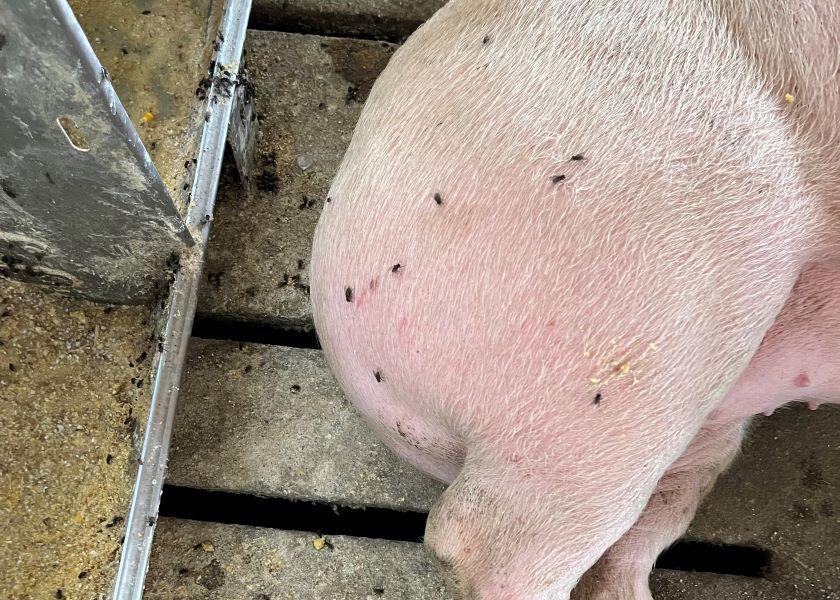Small Pests, Bigger Threats: Flies and Gnats Spread Swine Rotaviruses and Sapovirus

Annoying. Bothersome. Irritating. Inconvenience. Pest. No matter how you describe Musca domestica, aka the house fly, and its friend the gnat, one thing’s for sure – they are a nuisance and pose a threat to your swine herd.
Everyone knows the small stature of flies and gnats and their ability to fly allows them to easily enter and exit barns and vehicles while bringing with them viral, bacterial and parasitic pathogens. For the first time ever, a study led by Allison Knox of the Walcott Veterinary Clinic in Walcott, Iowa, shows the ability of house flies and gnats to transmit rotavirus and sapovirus in swine nurseries.
Staging the Study
Knox chose a sow farm and downstream nursery in southeast Iowa for the study as the farm had a history of both rotaviral and sapoviral challenges in pre- and post-weaning pigs. A pilot study conducted with these farms in 2021 evaluated proof of concept focused on polymerase chain reaction (PCR) testing and viral isolation of rotavirus serotype A.
“Positive PCR testing results were used to verify presence of rotaviral or sapoviral RNA, but cannot distinguish replicating, ‘live’ virus from inactive, ‘dead’ virus,” Knox explained. “Virus isolation is viral replication within laboratory settings, which is only possible with active, ‘live’ virus. Of the pathogens evaluated during the course of the study, laboratory technologies were only capable of performing virus isolation of rotavirus A, and is why virus isolation was not attempted on rotavirus B, C or sapovirus.”
In 2022, the farms were re-enrolled for the expanded study with additional samples collected focusing on rotaviruses A, B, C and sapovirus, Knox explained during the American Association of Swine Veterinarians annual meeting.
In the study, rectal swabs were collected from five nursing pigs out of a group of 500. Sampled pigs were chosen at the farm manager’s discretion with scouring or unthrifty pigs being the prime candidates, she shared. Samples were pooled and tested.
Two days pre-weaning, environmental samples and flies were collected from the clean and disinfected downstream nurseries and tested for rotaviruses and sapovirus. Traps were used with the goal of reducing potential cross-contamination from the environment, she noted.
Once weaned for approximately five days, pig rectal swabs and fly traps were recollected in the nursery. A third sample took place at 12 days post weaning.
Samples were tested at the Iowa State Veterinary Diagnostic Lab. Positive samples received follow-up sequencing and viral isolation.
A Look at the Results
In the pilot study, pigs were PCR positive for rotavirus serotypes A, B and C. Viral isolation attempts on the rotavirus A were successful, she said. The control trap had no PCR positives for rotavirus A, B or C.
“The pilot study showed proof of concept that in post-weaning nurseries where pigs were fecally shedding rotavirus serotype A, rotaviral RNA was detectable on or in flies and gnats via PCR testing,” Knox said. “Furthermore, it was possible to identify the rotavirus A as living virus via positive viral isolation.”
The continued study showed in two replicates that it was possible to isolate rotavirus A from flies at five days post-weaning. Sequencing of rotavirus A, B and sapovirus showed homologies close to or achieving a 100% match between the strains found in pigs compared to those found in the flies.
"This suggests that the flies were carrying strains shed from the pigs, or that the pigs had been infected by strains carried by the flies and gnats,” she said.
The exception was the rotavirus C of replicate 1, which showed flies were carrying strains isolated from the nursery environment but not the strain present in the pigs at that time. She points out that this may have been a result of having multiple rotavirus C strains involved, where only the dominant strain in each sample were sequenced or that not enough time had passed for pigs to acquire the second strain from the environment or from the flies.
“Another interesting finding in the study was that several of the control traps were positive for rotavirus A, B, C and sapovirus at one or more time points in each replicate,” she explained. “As these traps were covered to prevent insect entry, but still open to the air, it insinuates that rotavirus and sapovirus can be found in barn dust and particulates in the air.”
What This Means for Pork Producers
PCR values from the rotavirus and sapovirus found in the control traps were higher (lower amount of virus) as compared to what was identified in the pig samples or in the fly samples. She said this suggests flies and gnats in the barn are able to carry more virus or allow the virus to survive longer compared to virus suspended in barn dust or particulates.
“Flies and gnats are ubiquitous and hardy in the environment,” Knox said. “Because of this, new methods for prevention and control should be sought out. Practitioners and producers should consider including non-biting insect control protocols into farm biosecurity measures, as they may contribute to the reduction of rotavirus and sapovirus infections and transmission in swine nurseries.”
Read more:
Swine Veterinarians Share Wisdom Beyond the Farm at AASV Annual Meeting
Face Next-Generation Challenges in the Pork Industry Head On
Don't Miss This Power-Packed Line-Up at Leman Swine Conference







